How to make natural food coloring
Turn to the produce aisle to make gorgeous pinks, blues, purples, and more.
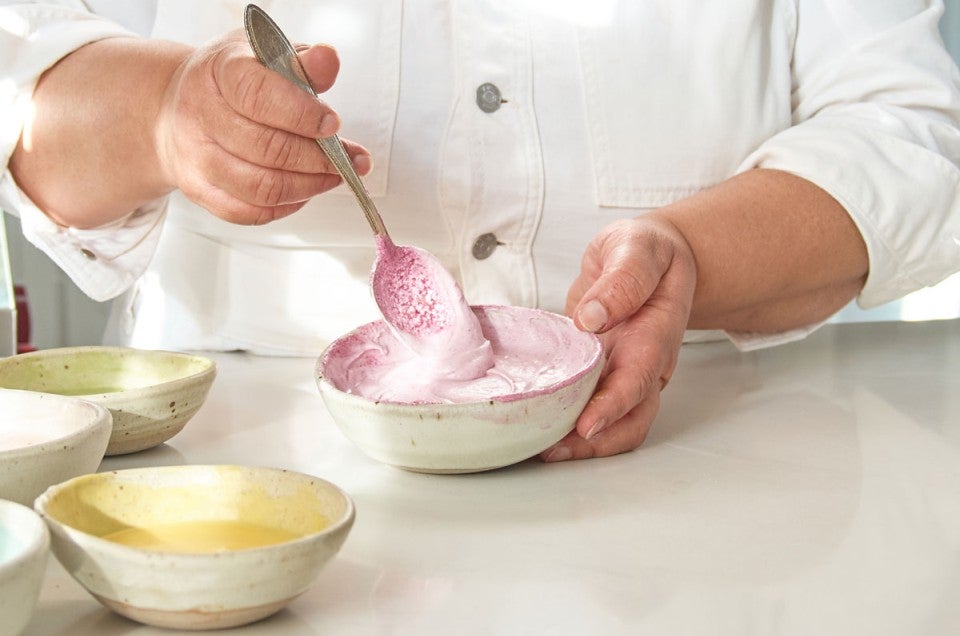

In her new cookbook, Cheryl Day’s Treasury of Southern Baking, baker Cheryl Day offers her tips for making your own natural food colorings using ingredients like turmeric, berries, cabbage, and more. Today, she's sharing those tips with us for all your decorating dreams. (Heads up: At King Arthur, we only recommend the cookbooks that we, as bakers, truly love. When you buy through external links on our site, we may earn an affiliate commission.)
* * *
I come from a long line of women who baked. I’m fortunate to have generations of handwritten recipes passed down to me, starting with my great-grandmother Hannah Queen Grubbs, on to her daughter (also named Hannah), and passed on again to my mother Janie Queen.
When I read in my mother’s journals that my grandmother Hannah frosted cakes in delightfully tinted colors, I started thinking about how she did it. My grandmother was a baker in the early 1940s, at a time when commercially made food dyes were not as widely available as they are today.
But Southern bakers are known for being resourceful, so I began to experiment with natural dyes like the ones my grandmother would have made. I used ingredients found in the grocery store produce aisle, such as freeze-dried strawberries, raspberries, blueberries, and even purple cabbage. The results are these colorful dyes — beautiful gifts of nature — that are as pretty to look at as they are delicious.
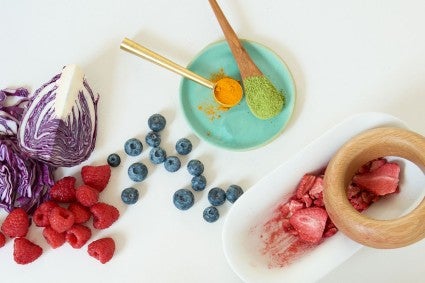
Now, when I bake, I know that I’m channeling the creative whimsy, innovation, and practical methods of my grandmother. I consider the legacy of recipes that were passed down to me some of my greatest treasures. From pastel pink cookies to sunny yellow buttercream roses, her inspiration lives on in the desserts I bake today.
You can use these food colorings in any of your favorite frosting or icing recipes. Try them in a confectioners’ sugar glaze for a smooth, artfully decorated canvas or whipped into buttercream frosting for a more textural finish — the perfect accompaniment for cookies, cakes, muffins, waffles, and doughnuts too!
Making and using natural food coloring
Natural food coloring is easy to make and a great alternative to store-bought food coloring. The best part is that you know exactly what goes into these colorings, unlike the mysterious chemicals often found in food dyes. These natural colors will tint icings and frostings for decorated holiday sugar and gingerbread cookies in beautiful natural hues, but they’re not recommended for baking in batters and doughs themselves, as the heat of the oven can wash out the colors.
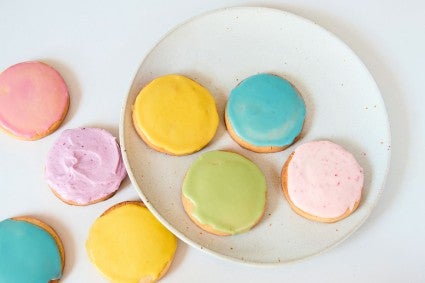
While preparing and using these colorings, be sure to tie on an apron to protect your clothing, a lesson I learned the hard way. Add the natural colorings to your icing or frosting a little at a time until you achieve your desired color, which can range from soft pastels to rich and vibrant shades.
The flavors in these colorings can also be a nice complement to your baked goods. For instance, the strawberries, raspberries, and blueberries have a light fruity taste. (Don’t worry, there’s no need to worry about cabbage-flavored frosting — the sugar in the blue-tinted dye offsets any lingering cabbage notes so its flavor isn’t detectable.)
The food colorings can be stored in an airtight container in the refrigerator for up to a week, or frozen in ice cube trays for up to one month. Just defrost before using.
In a small bowl, add 2 teaspoons strawberry powder to 2 tablespoons water, stirring to create a smooth paste. If you can’t find powder, you can make your own from freeze-dried strawberries by using a clean spice blender or mortar and pestle.
In a small saucepan, combine 2 cups (240g) raspberries with 1/4 cup (57g) water and bring to a gentle boil, then simmer for about 5 minutes; let cool. Strain the liquid through a fine-mesh sieve, then return the liquid to the saucepan and simmer until reduced to about 1/4 cup. It will have the viscosity of orange juice. Let cool completely.
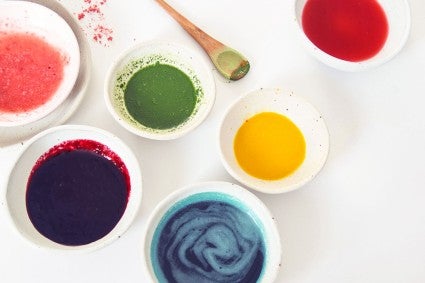
In a small saucepan, combine 2 cups (290g) fresh blueberries with 1/4 cup (57g) water and bring to a gentle boil. Reduce the heat slightly and simmer until the berries burst and break down. Mash the berries and strain through a fine-mesh sieve into a bowl, pressing on the berries to release as much liquid as possible; discard the solids. Return the liquid to the pan and boil until reduced to about 1/4 cup. It will have the viscosity of orange juice. Let cool completely.
In a small saucepan, combine 2 cups (190g) shredded purple cabbage with 1 1/2 cups (341g) water and bring to a gentle boil. Remove from the heat, cover with a lid, and let steep for about 15 minutes. Strain the liquid through a fine-mesh sieve into a bowl (discard the solids), then return the liquid to the saucepan. Add 1/4 cup (50g) sugar, bring to a simmer, stirring to dissolve the sugar, and continue to simmer until the liquid is a deep purple color and has reduced by half. Stir in 1/4 teaspoon baking soda, which will turn the liquid into a gorgeous shade of blue. It will be syrupy and bold. Let cool completely.
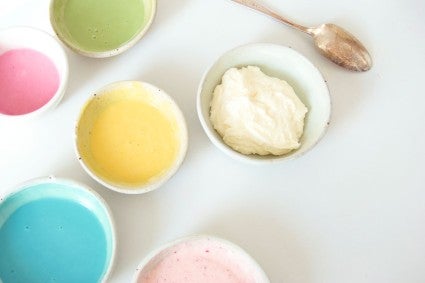
In a small saucepan, combine 1/4 cup (57g) water with 1/2 teaspoon ground turmeric. Bring to a gentle boil over medium heat, and boil until reduced by half into a thick paste. Let cool completely. Beware: Turmeric stains everything it touches.
In a small bowl, add 1 teaspoon matcha powder to 2 tablespoons water, stirring to create a smooth paste.
Ultimately, these homemade food colorings are ideal for bakers who are looking to put in the extra effort to make a truly DIY product. For bakers who are looking to avoid artificial colors but also need a shortcut, try this natural food dye.
Adapted from Cheryl Day’s Treasury of Southern Baking by Cheryl Day (Artisan Books). Copyright © 2021.
Cover photo by Haylie Waring.

